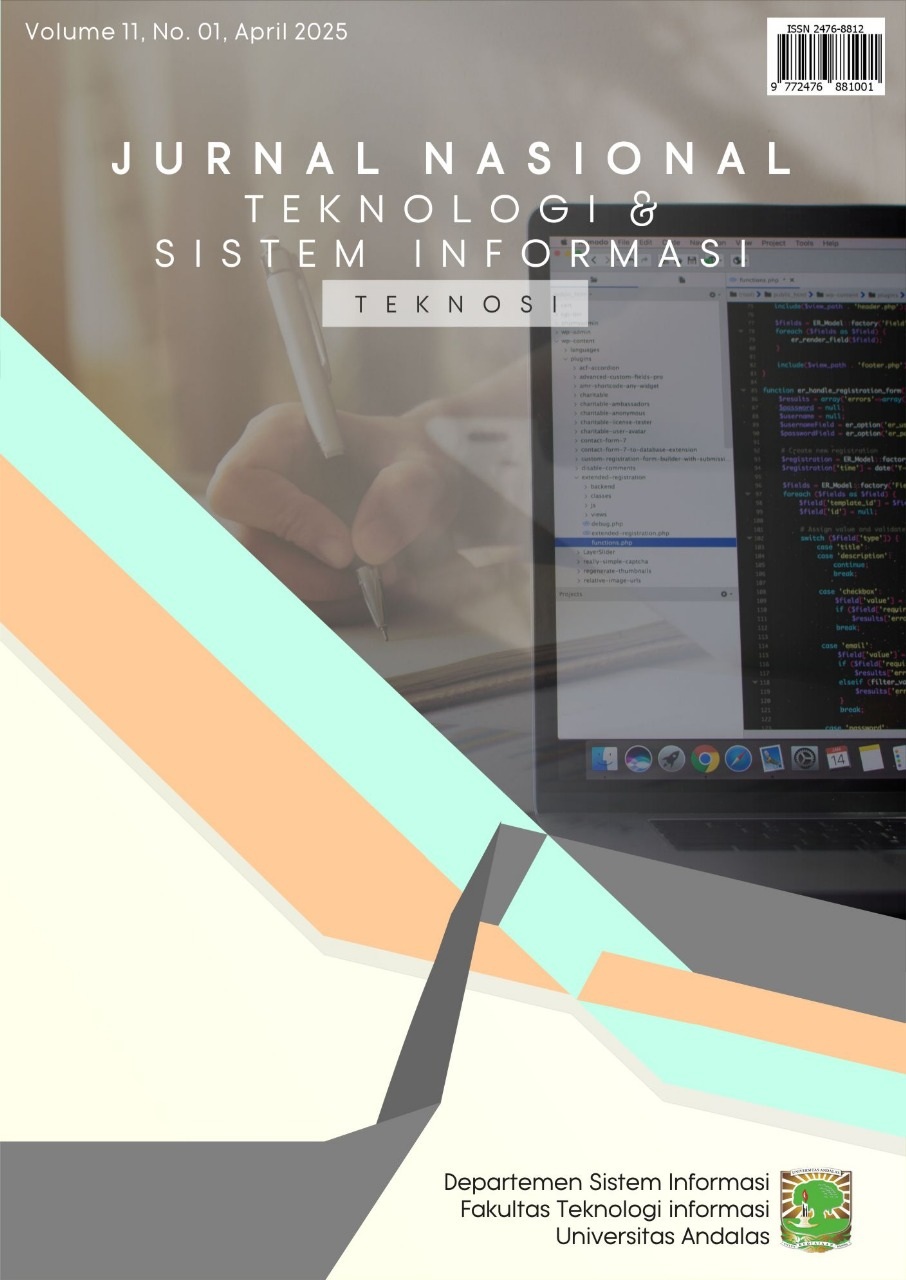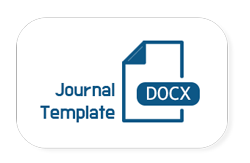Indonesia
DOI:
https://doi.org/10.25077/TEKNOSI.v11i2.2025.161-169Keywords:
IndonesiaAbstract
Air pollution is a serious problem that has an impact on the health and quality of life of people in metropolitan cities like Jakarta. To overcome these challenges, an accurate and reliable air quality prediction method is needed. Extreme Gradient Boosting (XGBoost) is a machine learning algorithm that excels at handling non-linear and complex data, making it ideal for modeling air quality. This study aims to develop an air quality prediction model in Jakarta using XGBoost, utilizing pollutant data that builds an Air Quality Index (AQI) obtained through a data mining process using the Earth Engine Code Editor.Model evaluation was carried out using RMSE, MAE, R2, and RSE metrics, which showed that XGBoost provided excellent prediction performance. The feature importance analysis identified SO2, PM2.5, and PM10 as the main factors affecting air quality in Jakarta. The results of this study are expected to support the government in making air pollution mitigation policies and developing an effective early warning system to improve the quality of life of the community.References
N. Sunusi, A. A. Sikib dan S. Pasari, “A novel hybrid CLARA and fuzzy time series Markov chain model for predicting air pollution in Jakarta,” MethodsX, vol. 14, 2025.
Z. Guo, X. Jing, Y. Ling, Y. Yang dan N. Jing, “Optimized air quality management based on air quality index prediction and air pollutants identification in representative cities in China,” Scientific Reports, vol. 14, 2024.
“Kota paling berpolusi di dunia,” IQAir, 2024. [Online]. Available: https://www.iqair.com/id/world-most-polluted-cities?continent=59af92b13e70001c1bd78e53. [Diakses 24 Maret 2025].
“Kebijakan Komprehensif Atasi Polusi Udara Jakarta,” Pemprov DKI Jakarta, 6 November 2023. [Online]. Available: https://www.jakarta.go.id/page/kebijakan-komprehensif-atasi-polusi-udara-jakarta. [Diakses 24 Maret 2025].
W. Gao, T. Xiao, L. Zou, H. Li dan S. Gu, “Analysis and Prediction of Atmospheric Environmental Quality Based on the Autoregressive Integrated Moving Average Model (ARIMA Model) in Hunan Province, China,” Sustainability (Switzerland), vol. 16, 2024.
J. Yang, Y. Tian dan C. Wu, “Air Quality Prediction and Ranking Assessment Based on Bootstrap-XGBoost Algorithm and Ordinal Classification Models,” Atmosphere, vol. 15, 2024.
S. Qian, T. Peng, Z. Tao, X. Li dan M. , “An evolutionary deep learning model based on XGBoost feature selection and Gaussian data augmentation for AQI prediction,” Process Safety and Environmental Protection, vol. 191, pp. 836-851, 2024.
A. Vatresia, R. Nafila, W. Agwil dan F. P. Utama, “Forecasting air quality index data with autoregressive integrated moving average models,” EQA, 2025.
T. Liu dan S. You, “Analysis and Forecast of Beijing’s Air Quality Index Based on ARIMA Model and Neural Network Model,” Atmosphere, vol. 13, 2022.
Z. Alfasanah, M. Z. H. Niam dan S. Wardia, “Monitoring air quality index with EWMA and individual charts using XGBoost and SVR residuals,” MethodsX, vol. 14, 2025.
T. Chen dan C. Guestrin, “Xgboost: A scalable tree boosting system,” Proceedings of the 22nd ACM SIGKDD International Conference on Knowledge Discovery and Data Mining, pp. 785-794, 2016.
X. Guo, Z. Zhang, Z. Cai, L. Wang, Z. Gu, Y. Xu dan J. Zhao, “Analysis of the Spatial–Temporal Distribution Characteristics of NO2 and Their Influencing Factors in the Yangtze River Delta Based on Sentinel-5P Satellite Data,” Atmosphere, vol. 13, 2022.
B. Pardamean, R. Rahutomo, T. W. Cenggoro, A. Budiarto dan A. S. Perbangsa, “The Impact of Large-Scale Social Restriction Phases on the Air Quality Index in Jakarta,” Atmosphere, vol. 12, 2021.
Almaliki, A. H, A. Derdour dan E, “Air Quality Index (AQI) Prediction in Holy Makkah Based on Machine Learning Methods,” Sustainability, vol. 15, no. 17, 2023.
D. Q. Duong, Q. M. Le, T.-L. Nguyen-Tai, D. Bo, D. Nguyen, M.-S. Dao dan B. T. Nguyen, “Multi-source machine learning for AQI estimation,” IEEE International Conference on Big Data (Big Data), 2020.
J. M. Kuhn dan K. , Applied Predictive Modeling, New York: Springer, 2013.
A. Jierula, S. Wang, T.-M. OH dan P. Wang, “Study on Accuracy Metrics for Evaluating the Predictions of Damage Locations in Deep Piles Using Artificial Neural Networks with Acoustic Emission Data,” Applied Sciences, vol. 11, no. 5, 2021.
K. Li, “Informativeness of Performance Measures: Coefficients or R-Squareds?,” Risk and Financial Management, vol. 17, no. 11, 2024.
Z. Wang, X. Wu dan Y. Wu, “A spatiotemporal XGBoost model for PM2.5 concentration prediction and its application in Shanghai.,” Heliyon, vol. 9, 2023.
J. Ma, Z. Yu, Y. Qu, J. Xu dan Y. Cao, “Application of the XGBoost Machine Learning Method in PM2.5 Prediction: A Case Study of Shanghai,” Aerosol Air Qual, vol. 20, pp. 128-138, 2020.
M. Z. Joharestani, C. Cao, X. Ni, B. Bashir dan S. Talebiesfandarani, “PM2.5 Prediction Based on Random Forest, XGBoost,,” Atmosphere, vol. 10, no. 3, 2019.
S. A. Meo, M. A. Salih, J. M. Alkhalifah, A. H. Alsomali dan A. A. Almushawah, “Environmental pollutants particulate matter (PM2.5, PM10), Carbon Monoxide (CO), Nitrogen dioxide (NO2), Sulfur dioxide (SO2), and Ozone (O3) impact on lung functions,” Journal of King Saud University - Science, vol. 36, no. 7, 2024.
Downloads
Submitted
Accepted
Published
How to Cite
Issue
Section
License
Copyright (c) 2025 Jurnal Nasional dan Sistem Informasi

This work is licensed under a Creative Commons Attribution-ShareAlike 4.0 International License.
Hak cipta untuk artikel ini ditransfer ke Jurnal Nasional Teknologi dan Sistem Informasi (TEKNOSI) jika dan ketika artikel diterima untuk publikasi. Yang bertanda tangan di bawah ini dengan ini mentransfer setiap dan semua hak di dalam dan ke kertas termasuk tanpa batasan semua hak cipta untuk TEKNOSI. Yang bertanda tangan di bawah ini dengan ini menyatakan dan menjamin bahwa makalah tersebut asli dan bahwa ia adalah pembuat makalah, kecuali untuk bahan yang secara jelas diidentifikasi sebagai sumber aslinya, dengan pemberitahuan izin dari pemilik hak cipta jika diperlukan. Yang bertanda tangan di bawah ini menyatakan bahwa ia memiliki kekuatan dan wewenang untuk membuat dan melaksanakan penugasan ini.
Kami menyatakan bahwa:
- Makalah ini belum diterbitkan dalam bentuk yang sama di tempat lain.
- Makalah ini tidak akan dikirimkan di tempat lain untuk publikasi sebelum penerimaan/penolakan oleh Jurnal ini
- Izin hak cipta diperoleh untuk materi yang diterbitkan di tempat lain dan yang memerlukan izin ini untuk reproduksi.
Selanjutnya, Saya/kami dengan ini mentransfer hak publikasi yang tidak terbatas dari makalah yang disebutkan di atas secara keseluruhan kepada TEKNOSI. Transfer hak cipta mencakup hak untuk mereproduksi dan mendistribusikan artikel, termasuk cetak ulang, terjemahan, reproduksi foto, mikroform, bentuk elektronik (offline, online) atau reproduksi lain yang serupa.
Penulis yang sesuai menandatangani dan menerima tanggung jawab untuk merilis materi ini atas nama setiap dan semua penulis bersama. Perjanjian ini harus ditandatangani oleh setidaknya salah satu penulis yang telah memperoleh persetujuan dari rekan penulis jika berlaku. Setelah pengajuan perjanjian ini ditandatangani oleh penulis yang sesuai, perubahan kepengarangan atau dalam urutan penulis yang tercantum tidak akan diterima.
Hak / Syarat dan Ketentuan yang dipertahankan :
- Penulis memiliki semua hak kepemilikan dalam setiap proses, prosedur, atau artikel manufaktur yang dijelaskan dalam Karya ini.
- Penulis dapat mereproduksi atau mengotorisasi orang lain untuk mereproduksi karya ini atau karya turunannya untuk penggunaan pribadi penulis atau untuk penggunaan perusahaan, dengan ketentuan bahwa sumber dan menyatakan hak cipta dimiliki TEKNOSI, salinan tidak digunakan dengan cara apa pun yang menyiratkan pengesahan TEKNOSI atas suatu produk atau layanan dari pihak mana pun, dan salinannya sendiri tidak ditawarkan untuk dijual.
- Meskipun penulis diizinkan untuk menggunakan kembali semua atau sebagian dari karya ini dalam karya lain, ini tidak termasuk mengabulkan permintaan pihak ketiga untuk mencetak ulang, menerbitkan ulang, atau jenis penggunaan ulang lainnya.
















